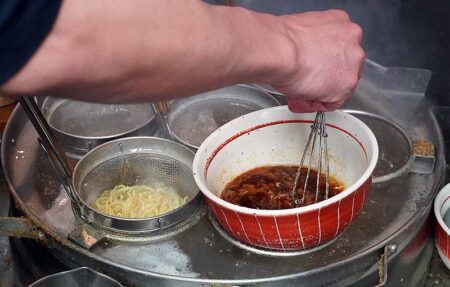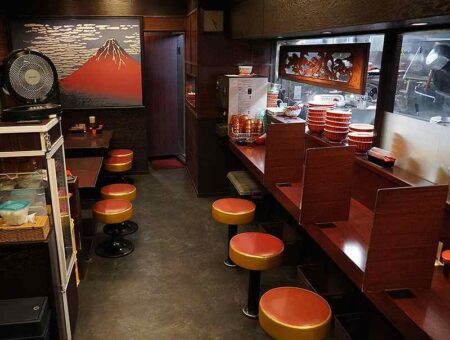
A bowl of Ashura’s sesame ramen with a seasoned soft-boiled egg
16:42 JST, December 14, 2020
Ashura, a ramen shop in Funabashi, Chiba Prefecture, takes its name from a class of Buddhist deity known as Ashura or Asura. While the Ashura are said to have been evil deities in ancient India, their four leaders took refuge in the Buddha and became protectors of the Dharma, or the natural order of life. I imagined that a person who would give their shop such a name would be a guy dripping with machismo, but as it turns out the owner, Takehiro Takeuchi, is a soft-spoken, earnest-looking person. When I asked him where he got the idea for the shop’s name, Takeuchi said, “I wanted to enjoy some of the benefits of Ashura’s popularity.”
When most people in Japan think of Ashura, they think of the Ashura sculpture at Kofukuji temple in Nara, a national treasure renowned for its beautiful face. It’s one of Japan’s most popular Buddhist statues and attracts many visitors. Takeuchi himself said that he bought a poster of the sculpture there just before opening his shop and he has that very poster on display to this day.

Ashura’s exterior

Owner Takehiro Takeuchi stands next to a poster of the Ashura sculpture in Nara.
Takeuchi previously worked for the famed Menya Musashi ramen shop chain that was named after Miyamoto Musashi, a swordsman in the Edo period (1603 – 1867). Before opening his very own shop he had been looking for a motif when he happened upon the Ashura.
Japanese-style sesame ramen

Sesame paste mixed with chopped ginger and garlic

Takeuchi warms a ramen bowl on a colander over hot water.
The most popular dish at Ashura is the sesame ramen. While tantanmen, a spicy ramen made with sesame paste and Chinese condiments, such as Chinese chili bean sauce, is popular in Japan, Ashura’s sesame ramen is more of a Japanese-style dish because of its use of ingredients such as Japanese peppers, shiso perilla leaves and bonito flakes, which frequently appear in Japanese cuisine.
Takeuchi showed me just how the popular dish is made. First, sesame paste, the basis of the dish’s flavor, is mixed with chopped garlic, ginger and Japanese peppers. Then, a soy sauce-based sauce flavored with dried bonito flakes and dried sardines, and broth with a pork, chicken and kombu base are added to the mixture. Finally, after the noodles are added, the dish is topped with slices of chashu roast pork, chopped shiso perilla leaves and green onions.

Takeuchi prepares some ramen noodles

Chashu roast pork
As the aroma of the dish’s sesame and garlic hit me, I began to feel even hungrier than when I came in. Contrary to the rich and creamy broth of tantanmen, the broth of Ashura’s signature dish is thinner. As I took my first taste of the broth, I enjoyed the mild flavor of the broth that accompanied the rich sesame flavor.
After trying the products of several companies, Takeuchi now purchases his sesame paste exclusively from a company in Mie Prefecture. The noodles he uses are curly and of a medium thickness and their rich wheat flavor harmonizes well with the flavor of the broth.
By the time I’d gotten halfway through the dish, I realized that the flavor had changed. I took another sip of the broth to see if I could figure out just what had changed. The chopped ginger that had settled at the bottom of the bowl had come up to the surface. Even though the ginger couldn’t be seen, it’s undeniable kick was easy to detect. I was really impressed with the way the dish’s flavor naturally changed as I ate it.
“I make sure I coarsely chop the ginger in a blender to bring out its flavor,” Takeuchi said with a smile.

Shiso perilla leaves

Chopped shiso perilla leaves and green onion
Another point worth mentioning is the chopped shiso perilla leaves. This is a vegetable that is commonly used in Japanese cuisine, often paired with sashimi or served over tofu. Its addition to this dish gives it an elegant and refreshing taste.
Carrying the torch

Takeuchi’s passion for sesame ramen comes from a sesame ramen dish that he would often eat at a shop in Funabashi in his early adulthood. He loved the dish so much that after he got his driver’s license, he would often take a drive to the shop.
That particular dish sprang to mind when he coming up with a limited-time-only dish during his time at Menya Musashi, where it was very well received. So much so, that he decided to make it the signature dish of his shop, which he opened at the age of 29.
The ramen shop Takeuchi frequented in his younger days no longer exists. He says that the flavors of that ramen and his own are different. But I feel it’s a strange twist of fate now that he serves the very dish that he loved as a customer all those years ago.

Ashura’s interior

A reproduction of Gaifu Kaisei, or Red Mt. Fuji, a painting by the ukiyo-e artist Katsushika Hokusai in the Edo period
Even though we had begun talking in the middle of the afternoon, before I knew it the sky outside had grown dark and the autumn sun had almost completely set. Takeuchi kindly sent me on my way, asking me to please stop by again soon. I’m not sure if it was because of the ginger and garlic, but my body began to feel warm. As I made my way home, I thought to myself, “Maybe if I keep eating this ramen, I can avoid catching a cold.”

Ashura
2-7-3 Minato-cho Funabashi, Chiba Prefecture.
Open from 11 a.m. to 3 p.m. and 6 p.m. to 9:30 p.m. Tuesday – Saturday, from 11 a.m. to 3 p.m. on Sundays. Closed on Mondays.
A bowl of the signature ginger ramen costs ¥740 and a seasoned soft-boiled egg can be added for an additional ¥100.

Chikako Minami, Japan News Staff Writer
Enjoys making ramen using a meal kit at home at least once a week and baking various types of bread.

"JN Specialities" POPULAR ARTICLE
-

The Japan News / Weekly Edition (12/12-12/18)
-

Noodle Dining Shunsai / Rich Oyster Ramen to Savor at Odasaga; Experienced 68-year-old Owner Creates Numerous Ramen Varieties
-

The Japan News / Weekly Edition (12/5-12/11)
-

People Keep Loved Ones’ Ashes Close in Special Jewelry, Small Urns as Unique Way to Memorialize Them
-

The Japan News / Weekly Edition (12/19-12/25)
JN ACCESS RANKING
-

Tokyo Economic Security Forum to Hold Inaugural Meeting Amid Tense Global Environment
-

Keidanren Chairman Yoshinobu Tsutsui Visits Kashiwazaki-Kariwa Nuclear Power Plant; Inspects New Emergency Safety System
-

Imports of Rare Earths from China Facing Delays, May Be Caused by Deterioration of Japan-China Relations
-

University of Tokyo Professor Discusses Japanese Economic Security in Interview Ahead of Forum
-

Japan Pulls out of Vietnam Nuclear Project, Complicating Hanoi’s Power Plans



























